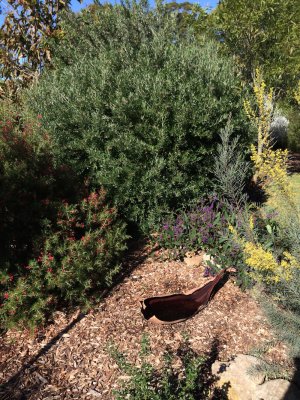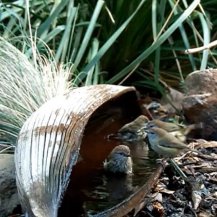You are here
Home ›#teambirdnerd: Lea-Ann Ledden
The Birds in Backyards Program meets extraordinary people every day. Lea-Ann Leaden is a member of our wonderful community who has, over the last 6 years, been transforming her garden into a bird paradise. Lea-Ann agreed to answer some questions about what she has done in her garden, and why…
Why did you embark on creating a bird-friendly garden?
I have ‘my nest’ my home, an old 1940’s miners cottage. My home is for me - the land is for them, so when I step out my door, I step into another world, I don’t like outdoor rooms, outdoor kitchens, pools etc. I think humans take up too much space on land today that we all should be rethinking how we manage our land, we have our homes… we all need to learn how to share and to give back, we need to realise they too are the rightful owners of all the land, that they too need homes, need shelter, a place to raise their families, a place to eat, to drink, to bathe, just like us.
Tell us a little about your garden?
My suburban block is 850sqm that is situated at the foothills of the escarpment of the northern Illawarra. My wildlife garden has taken me, ‘by myself’ just over six and a half years to create. I had to remove weeds like lantana and morning glory so I did my garden in small stages and pretty much out of nesting season - hence why it took extra-long. Many people would wipe out everything, not realising even weeds provide habitat and that extra care should be taken when removing them and what time of year to do. I have a few stages yet to do, one being a tiny hill on my southern side and the main centre garden.
I have seen my bird list grow over the last six years, my garden has reached 48 bird species who visit. The last bird added in Winter this year who was new to our garden was the White-cheeked honeyeater.
Is the garden high or low maintenance?
My garden is a low maintenance wildlife garden. This way I encourage an amazing variety of insect life and other invertebrates to my garden as well, I believe that everything that slithers, crawls, hops or buzzes are a vital part of our ecosystem that we couldn’t possibly have a healthy garden without them, I love learning the importance of all these wonderful little creatures as I see them, for example how spiders and moths call my cycads home, but to a Superb Fairy-wren it is a food market to where they find many hidden insect treats that they love to feast on, I have had the male Superb Fairy-wren leave his two young at the base of the cycads, well protected where they would learn to hunt for their food, he would return with crickets, baby caterpillars and many little leaf hoppers, I watch and think just how important all those treats are in their organic state… I believe when we don’t use chemicals, it’s only then do we create a healthier ecosystem for all our local wildlife that live in or visit our gardens.
What is the composition of it? Any plants you particularly love?
All Australian natives with some locally native. Some exotic species planted by previous owners and instead of removing them I kept them as I seen the value of what these plants provided for our wildlife over the first couple of years, for example – cycads that provide a safe haven for our superb fairy wrens who love to shelter in them and feed on the many insects that hide in the mass of fronds, the china doll tree that provides seed pods that the crimson rosella love to feed on every year and the brushtail and ringtail possums love eating the new shoots.
I have planted all Australian native plants, many prickly grevilleas, tea trees, melaleucas and one Bursaria spinosa that is very prickly, some kangaroo paws, wattles, ferns, grasses, mat rushes, scurvy weed, native violets, hop bushes, bottle brushes, lily pillys, tree ferns and a little gum tree, Gymea lily and a few others.
Kunzea ambigua - White Kunzea/Tick Bush is a favourite. People think I’m crazy when I say this is a beautiful shrub, doesn’t seem to be very popular, I have tip pruned one to help make it lovely and dense as the little birds love these shrubs for insects and protection, bandicoots love to make a shallow nest below them, Eastern Water Dragons and Satin Bowerbirds love snapping up the bees that the flowers attract, and I especially love them for the gorgeous little flowers, you have to look close to really admire the flower in all its closed and open stages… most of all I love this plant for its strong honey aroma… it’s heavenly.
What are your favourite features in your garden?
I think a very important tip when creating a wildlife/bird friendly garden is to create an inner bird haven with a bird bath. This is a clear open circle surrounded by bushes where they feel protected and safe. It is where they love to bathe, love to communicate, to mate etc… I have seen these inner bird havens I have created loved the most more than any other areas in my garden.Another one the birds love is the keyhole design, I love this one too as I can see a little into there world through the keyhole, it’s lovely seeing them so at ease and comfortable in these areas they all love to visit.I also use palm pods as bird for little birds, though with that said the larger birds have many of times used them too, also our bandicoots and the Red-bellied Black snakes as well as a very cheeky Eastern Water Dragon all summer long that I had to give him his very own one to bathe in. The palm pods are a huge hit with all the birds and wildlife that live here or visit… though with that said I never recommend people growing the palm tree that the pods fall from as this palm does a lot of harm to our native bats, though with that said there are so many in my local area that they were easy to come by and a wonderful way to reuse a little nature and the birds all proved to like these more than a man made bird bath as they neglected all the other baths and chose these pods, they have been the best bird baths for little birds especially as the inner lining is naturally ribbed and little ones love to have that grip at their feet.
What are your next plans for your garden?
My garden has a lot of growing to do, I have one year of work left to complete the final stages, I know a garden is never finished, but my last stages will be completed by the end of next year, gardening maintenance will continue to be low as the last of the lawn will also be gone, I look forward to that stage as this will make my garden a more peaceful place without the noise and disturbance of a mower, will just be maintaining the weeds as they pop up and sit back on the veranda with a cup of tea and home baked cake and have more time to enjoy all the lovely wildlife that come in.
And not too far away… eventually the inner bird haven areas will become more sheltered as plants grow and in time will be a lovely little hidden world, a refuge for the birds, animals and me too.










